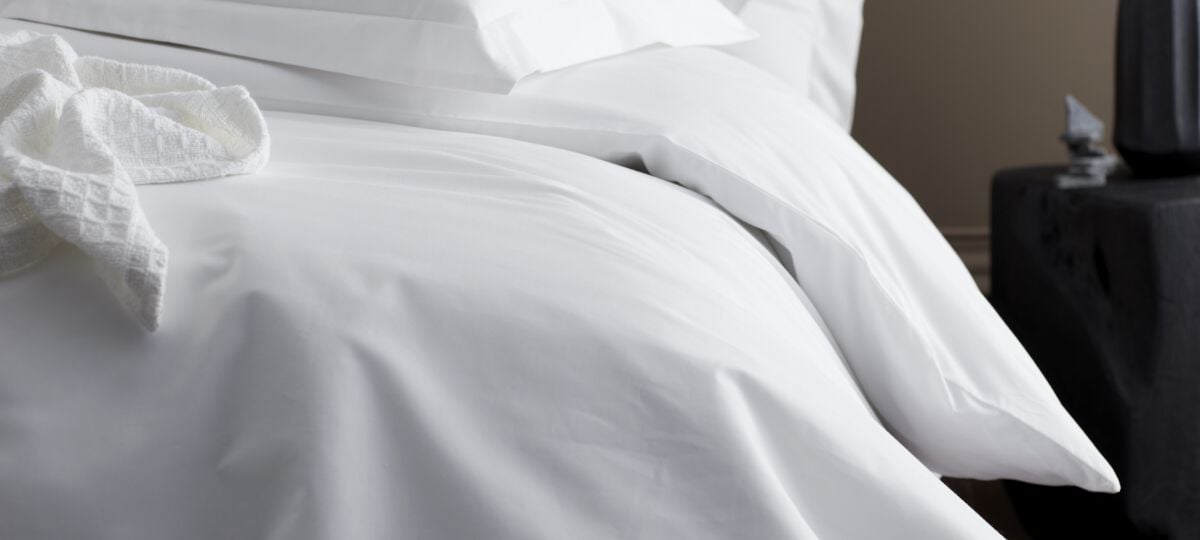Tips and Tricks for Duvet Cover Care
A duvet cover is a double-duty bedding piece that keeps your comforter protected while brightening your space. But, your duvet cover needs to be laundered regularly to stay fresh and clean. Explore this guide for information on how to wash duvet covers, including tips for fewer wrinkles and better longevity.
Can I Clean My Duvet Cover in the Washing Machine
While you should refer to manufacturer instructions prior to machine-washing yours, most duvet covers can be washed in the machine. First, determine which detergents and stain treatments are safe for use: while a gentle detergent and non-chlorine bleach may be fine, it’s always best to follow the care instructions that came with your bedding.
Instructions for Machine-Washing a Duvet Cover
Don’t skip the sort step when washing your bedding—you should launder your duvet with other bedding items of similar colors. Ensure there is enough space in the washing machine for your duvet cover to move around, but not too much space, as the bed linens need to rub together during the wash cycle to get clean.
Can You Wash a Duvet Cover With a Comforter Inside?
No, for best results and to prevent damaging the duvet cover or insert, you should remove the comforter before laundering.
Follow manufacturer instructions, or refer to these general steps:
- Put your duvet cover in the washing machine drum.
- Add a mild detergent where indicated by your machine. You may also add non-chlorine bleach as needed; bleach sparingly to prevent damaging or weakening the duvet cover’s fibers.
- Wash your duvet cover using the cold water setting and a gentle wash/spin cycle.
- After the cycle is complete, remove the duvet cover from the washing machine, shake it out gently, and dry promptly.

How Often Should You Wash Your Duvet Cover?
A duvet cover offers a protective layer that keeps your duvet insert or comforter in better shape, longer. While you only need to wash a comforter twice per year, a duvet cover should be laundered more often. If you don’t spend much time in bed beyond sleeping, wash your duvet cover every two to four weeks. If you often watch television, read, or spend other time in bed—or if your furry friends sleep with you—you may find that you need to wash your duvet cover more often.
Duvet Cover Tip: If you spill something on your duvet cover, remove and wash it right away to stop the spill from seeping into your comforter and to prevent any staining.
Can I Put My Duvet Cover in the Dryer?
Most duvet covers can go in the dryer. For the best results, choose a low or medium heat setting and don’t run the cycle any longer than necessary. If you dry it too long, you risk damaging the duvet cover’s material.
Duvet Cover Tip: Toss some wool dryer balls into the dryer. They punch and fluff the fabric, allowing in more air to help your bedding dry quicker, soften the fabric, and reduce wrinkles.
How do I Prevent my Duvet Cover from Wrinkling?
While some duvet cover materials, including sateen, bamboo, and TENCEL™ Lyocell, are naturally wrinkle-resistant, you can further prevent wrinkling with these tips:

- Use a gentle wash setting to help prevent tangling during the rinse and spin cycles, ultimately reducing wrinkling.
- Measure your detergent carefully—too much can contribute to wrinkles—and use an extra cold-water rinse cycle occasionally to remove any build-up.
- Remove your duvet cover from the dryer and fold it right away once it’s dry to prevent creases and wrinkles from setting in.
- If the bedding care label states that it’s okay, you can iron any wrinkles or creases left in the fabric after laundering. Quick tip: Turn the cover inside-out and iron on the reverse side for a smooth finish.
- When folding your bedding, smooth the duvet cover fabric between each fold so it’ll emerge from storage looking crisp and fresh.
Your duvet cover takes up a large amount of bedding real estate, so keep it fresh, clean, and wrinkle-free with these care instructions. Explore our other Guides for more bedding tips and tricks.